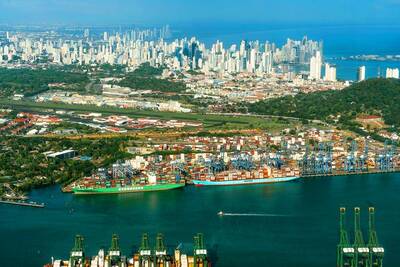The military said it is able to effectively detect military deployments in China through the use of unmanned aerial vehicles (UAVs), after it expanded detection zones from airspace over eastern and southern Taiwan to airspace over the Taiwan Strait.
According to a military official, who wished to remain anonymous, the US has expressed concern over how the UAV project has developed and military missions the drones are commissioned to perform.
The US has demanded that the Ministry of National Defense send specialists to brief the US Department of Defense on the project before a delegation was to head to the US for a meeting about bilateral cooperation on military issues involving high-level officials from both countries, the military official said.

Photo: Fang Pin-chao, Taipei Times
A UAV launched from a base in western Taiwan would be able to detect military movement in China’s southeast coastal area, he said.
Given Taiwan’s proximity to China, the capability of the UAVs to detect military deployments on the other side of the Taiwan Strait is highly valued by the US, he said.
Despite the US having sophisticated UAVs that can fly long distances to access the area, there are concerns within the US military that such missions would be costly, as well as there being political and military issues preventing its use of UAVs in the area, he added.
The UAV development program was undertaken by the National Chungshan Institute of Science and Technology. It has delivered 32 UAVs to the army.
In addition to Taimali (太麻里) in Taitung County, where the UAVs are based and training exercises are carried out, the ministry has been in talks with the Civil Aeronautics Administration over the possibility that part of the Hengchun airport in Pingtung could be used as another training base for the drones.
According to sources from the military, the air force’s airspace training area is within the range of missiles deployed in southeast China, making it impossible for the air force to carry out missions in the areas that the UAVs can access.
The military said it was still deliberating whether it would deploy the UAVs in western Taiwan.

LIMITS: While China increases military pressure on Taiwan and expands its use of cognitive warfare, it is unwilling to target tech supply chains, the report said US and Taiwan military officials have warned that the Chinese People’s Liberation Army (PLA) could implement a blockade within “a matter of hours” and need only “minimal conversion time” prior to an attack on Taiwan, a report released on Tuesday by the US Senate’s China Economic and Security Review Commission said. “While there is no indication that China is planning an imminent attack, the United States and its allies and partners can no longer assume that a Taiwan contingency is a distant possibility for which they would have ample time to prepare,” it said. The commission made the comments in its annual

DETERMINATION: Beijing’s actions toward Tokyo have drawn international attention, but would likely bolster regional coordination and defense networks, the report said Japanese Prime Minister Sanae Takaichi’s administration is likely to prioritize security reforms and deterrence in the face of recent “hybrid” threats from China, the National Security Bureau (NSB) said. The bureau made the assessment in a written report to the Legislative Yuan ahead of an oral report and questions-and-answers session at the legislature’s Foreign Affairs and National Defense Committee tomorrow. The key points of Japan’s security reforms would be to reinforce security cooperation with the US, including enhancing defense deployment in the first island chain, pushing forward the integrated command and operations of the Japan Self-Defense Forces and US Forces Japan, as

IN THE NATIONAL INTEREST: Deputy Minister of Foreign Affairs Francois Wu said the strengthening of military facilities would help to maintain security in the Taiwan Strait Japanese Minister of Defense Shinjiro Koizumi, visiting a military base close to Taiwan, said plans to deploy missiles to the post would move forward as tensions smolder between Tokyo and Beijing. “The deployment can help lower the chance of an armed attack on our country,” Koizumi told reporters on Sunday as he wrapped up his first trip to the base on the southern Japanese island of Yonaguni. “The view that it will heighten regional tensions is not accurate.” Former Japanese minister of defense Gen Nakatani in January said that Tokyo wanted to base Type 03 Chu-SAM missiles on Yonaguni, but little progress

IN THE MIDDLE: Some of the lawmakers defended the trip as an opportunity for investment, cooperation and to see models that could help modernize Panama A planned trip by some Panamanian lawmakers to Taiwan has unleashed the latest diplomatic spat with China as the Central American country tries to navigate the turbulent waters between the Asian superpower and the US. The Panamanian Ministry of Foreign Affairs and the US ambassador to the country on Wednesday criticized China’s diplomats in Panama for asking the lawmakers to cancel their trip to Taiwan, with the ministry accusing the Chinese embassy of “meddling” in its internal affairs. That followed comments from Panamanian President Jose Raul Mulino a week earlier saying that the planned Taiwan trip did not have the approval of